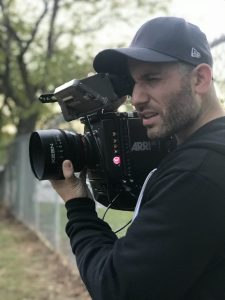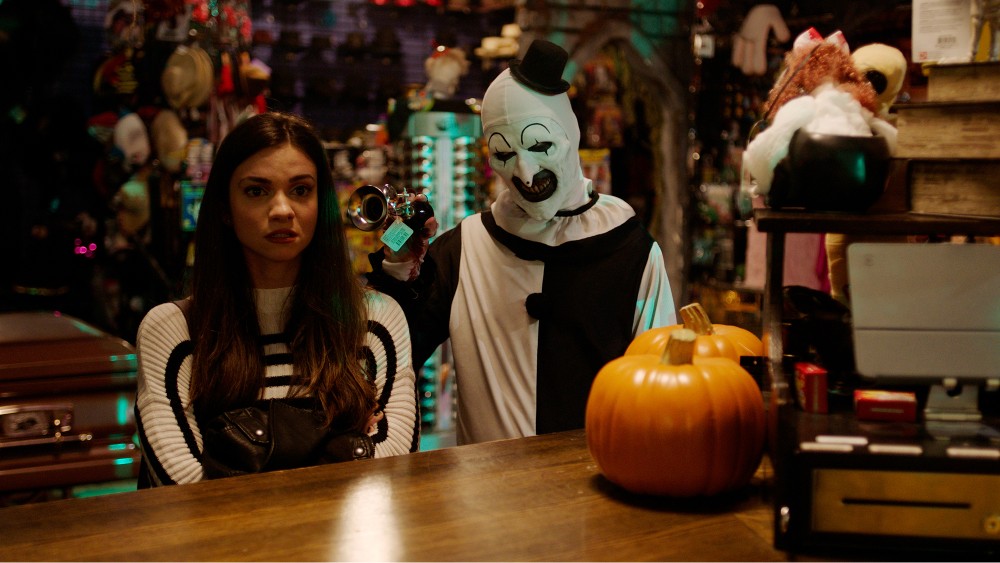If you’re a horror fan, chances are you’ve heard about how a gory indie flick, Terrifier 2, has been blowing up the box office, where it has been slowly rising up the top 10. The success of this low-budget indie, which was essentially built on a grassroots campaign, offers a pretty amazing story given the film’s lack of a major marketing spend — one that proves horror is no joke when it comes to profits.
The fact that Terrifier 2 has become such a hit in the middle of a market that’s already chock-full of horror offerings, including Paramount’s mega-hit Smile and Universal’s Halloween Ends, is remarkable all on its own. And while both of those movies are plenty gruesome themselves, it’s clear that Terrifier 2 owes its success, in part, to the fact that its filmmaker, the special FX master Damien Leone, pulled no punches with his unrated slasher flick, which features a silent killer known as Art the Clown.
David Howard Thornton plays Art, who basically goes around killing anyone he encounters in increasingly horrific ways. Unlike the first Terrifier, Leone’s 138-minute sequel also has an actual story, which involves a brother and sister who are trying to stop Art’s bloody rampage.
As of this past Sunday, Terrifier 2 has grossed $5.2 million, which might not seem like much, but compared to its minuscule production budget of just $250,000, it’s rather incredible, especially when you consider that the film was never intended for a nationwide theatrical release on 1000+ screens.
Originally, Terrifier 2 was going to get a quick theatrical release before streaming on Screambox, which originated from the horror website Bloody Disgusting. Presumably, a lot of people had seen Art the Clown in Leone’s Terrifier (rather than in Leone’s 2011 short film or his 2013 effort All Hallow’s Eve), and they came out in force to watch Art try to top his last killing spree, as Terrifier 2 grossed $403, 900 on its first day of release in 886 theaters on Thursday, Oct. 6.
By that Sunday, Terrifier 2 had made $1.2 million, with an additional $805,000 over the three-day weekend. From there, the movie started making more and more money each successive weekend, and that’s despite many theaters only playing it once per day, and sometimes, only late at night, as was the case with AMC Theatres. At this point, in the run-up to Halloween, the movie is getting more screenings each day — sometimes up to four, though no more, given the movie’s lengthy running time. But the word-of-mouth success of Terrifier 2 has forced many box office analysts (myself included) to rethink what is possible in terms of theatrical releases these days.

Unlike other indie horror filmmakers, Leone handles the special effects makeup for the Terrifier movies himself, so he can make the gore as graphic and out-there as his mind can imagine. There is stuff in Terrifier 2 that would normally get an NC-17 rating if put before the MPA, but instead, the movie has hit theaters unrated, so there are none of the usual limitations. Then again, it’s not like the sequel is being advertised on television or in print ads, so who even knows (or cares) what the rating is — they know what to expect, if not because of sites such as this one, then certainly via social media.
Distributor Cinedigm is probably best known for its VOD fare more than its theatrical releases. In fact, if you look at Cinedigm’s box office history, its highest-grossing movie was Destin Daniel Cretton’s early indie drama Short Term 12, which starred Oscar winners Brie Larson and Rami Malek, as well as Oscar nominee Lakeith Stanfield, and even Kaitlyn Dever. That movie made just $1 million at the U.S. box office, so Terrifier 2 is the most successful movie in the history of the company. No wonder Leone is already talking about Terrifiers 3 and 4…
This kind of phenomenon is nothing new, of course. In the ’50s, William Castle figured out how to make turn horror movies into genuine events — and this was before the days of home video and streaming — by incorporating gimmicks in the theaters, like having the seats lightly electrified for The Tingler, or having “ghosts” flying over the audience’s heads.
In 1968, the late George Romero made the super low-budget zombie movie Night of the Living Dead, which launched an entire franchise (one that is now being resurrected) that really exploded with 1978’s Dawn of the Dead, a film that was released amid a wave of horror movies that would push the R-rating as far as possible.

By the ’70s, directors like Francis Ford Coppola and Martin Scorsese were making names for themselves with award-winning movies such as The Godfather and Taxi Driver, both of which are among the most violent acclaimed films of all time. But sandwiched in between them was Tobe Hooper‘s 1974 horror masterpiece The Texas Chainsaw Massacre, which upped the ante on the amount of graphic violence that a filmmaker could put in a theatrical movie. In terms of violence, Wes Craven, who had already made 1972’s The Last House on the Left, tried to top himself with 1977’s The Hills Have Eyes, which was followed a year later by John Carpenter’s slasher classic Halloween. Those three filmmakers helped define the slasher genre and change the face of horror for the ’80s (when David Cronenberg picked up the torch with Scanners, Videodrome, and The Fly), ultimately paving the way for other scrappy scary movies such as Terrifier 2.
Speaking of that film’s lineage, I’ll offer a special shout-out to the original Friday the 13th, as that movie also had young people talking in 1980 — something I know since I actually went to high school with the original Jason Voorhees, Ari Lehman, and the brutal kills were all my classmates were talking about that year.
Although horror continued to do well in the ’80s, with major hits from some of the directors mentioned above, it also became more ensconced in the studio system, to the point that Tobe Hooper was recruited to direct 1982’s Poltergeist. Though Steven Spielberg was busy directing E.T. the Extra-Terrestrial, he was heavily involved in that movie, but it might have turned out very differently had he not collaborated with Hooper, who I presume was the one who insisted on including the sight of a man ripping his own face off — one of many things in Poltergeist that got people talking and helped make it one of the year’s biggest hits… though I’m sure the film’s baffling PG rating didn’t hurt either…
We can track the success of Terrifier 2 to more recent horror hits that also offered dared to offer the audience something new. The found-footage film The Blair Witch Project became a box office sensation that birthed a new format, for better or worse, and a few years later, James Wan and Leigh Whannell broke out in the States with their gory Saw, which began a wave of movies that were unfairly dismissed as “torture porn,” but once again broke new ground in terms of how far the horror genre could be pushed. Wan (The Conjuring) and Whannell (The Invisible Man) would go on to become modern stewards of the genre to some extent, though both of them are firmly entrenched in the studio system, where anything deemed too gory or intense would force a filmmaker to contend with the mighty MPA.
It would be another 10 years before horror started being truly dangerous again, albeit in a more “elevated” way, with horror fans embracing movies like Hereditary and The Witch, which hail from the genre’s rising stars, Ari Aster and Robert Eggers. As such, horror has become a bit more prestigious, and Aster and Eggers both went on to work with Oscar-winning actors such as Joaquin Phoenix (A24’s upcoming Disappointment Blvd.) and Nicole Kidman (The Northman).

The point of the abridged horror history lesson above is to illustrate how horror movies that break conventional movie taboos, which Terrifier 2 most certainly does, are nothing new, though they are almost always successful. However, like any “trend,” these things come in waves and are often cyclical. Almost every horror sub-genre, whether it be slashers or vampire movies, or zombie movies, tends to burn bright and then flame out, at least until some filmmaker comes along with a new take on a classic horror trope.
That is exactly what Terrifier 2 does, and it also goes against the grain by being the rare movie to rack up millions in theatrical receipts despite being a sequel to a film that barely even got a theatrical release the first time around. Horror fans aren’t terribly discerning, they just want to be surprised and scared and horrified. Terrifier 2 delivers on all of these fronts, so I believe the rumors about disgusted patrons vomiting in their seats — that’s if they make it through the entire movie. I imagine there have been plenty of walk-outs from curious looky-loos who had no idea what they were getting themselves into.
But whether those reports are true or not, they represent the kind of word-of-mouth that drive huge horror hits, and that’s how Terrifier 2 is managing to thrive in a crowded market right now. It’s even defying the usual frontloading that theatrical horror movies typically face — usually, the core audience shows up on opening weekend before moving on to something else. However, in this case, it’s pretty obvious that people who see Terrifier 2 are telling their friends they absolutely need to see the gore in this movie and test their own limits. This is a trend that will no doubt continue as audiences become increasingly desensitized and filmmakers steel themselves to cross the lines of “good taste” as dictated by the Hollywood studio system and make horror movies shocking and disturbing again, rather than rote and familiar.
Terrifier 2 expands into 1,500 theaters today, with a lot more showings each day given that it’s the weekend before Halloween, so check out our Box Office Breakdown on Sunday to see if this grisly phenomenon keeps making a killing in theaters. You can also read Neil Turitz’s thoughts on this year’s other horror films in his recent column for Above the Line.

Edward Douglas has been writing about the box office for 21 years at places like ComingSoon.net, The Tracking Board, and many others, but mostly under the banner of “The Weekend Warrior.” He’s also a film critic with bylines at Film Journal, The New York Daily News, Den of Geek, and many others.
His Box Office Breakdown is posted every week by Monday morning, and you can also read other features by Edward Douglas over at Below the Line.



